It’s 6:47 PM. You’ve done five Botox appointments, four filler treatments, three laser sessions, two long consults, and one urgent visit about a ‘weird bump’ that turned out to be just uneven swelling. You’re finally walking out the clinic door, one hand balancing a half-eaten protein bar, the other holding your phone. It pings—again.
“Hi! Just wondering if I can go to a sauna after my lip fillers?”
You stop. You squint. You sigh. Didn’t this same question come in three hours ago... from someone else?
“Why does everyone want to go to the sauna all of a sudden??” is the response you’re dying to text back. But you don't.
Instead you answer with a well thought out, polite and medically sound response. Because you’re good like that. Because patient care matters. Because if you don’t, she’ll ask Doctor Google, and we all know how that will end:
"Yes, but also you might die of filler migration and brain swelling"—thanks, WebMD.
It’s 2025—aren’t we living in the future?
There’s a smarter way to do this: artificial intelligence, your new assistant that never sleeps, never eats your snacks, and never needs a coffee break.
AI Is Not Replacing You. It’s Replacing the Chaos.
“AI? Really, Sam? You’re one of those people?”
I get it. AI has become one of those buzzwords, right up there with “pivot,” “synergy,” and that guy on LinkedIn who swears his 4 AM cold plunges have 10X'd his productivity. You’re right to be skeptical when every Patagonia-wearing tech evangelist in Silicon Valley is trying to sell you something.
There is plenty of overhyped nonsense surrounding AI. But there’s also real value, and the most forward-thinking practices are already using it to make their lives easier and their patients happier.
Consider this:
Did you go to medical school to become a human autoresponder?
Was burning out on Botox questions a key component of your business plan?
Is playing scheduling-Tetris the best part of your day?
I didn’t think so.
AI takes away the busy work so you can focus on the work only you can do. The work that actually changes the lives of your patients. The work that has a real impact on your bottom line. The work that produces the meaning and satisfaction you want from your career.
You can use AI to safeguard your sanity and deliver better care at the same time.
It’s time to embrace Patient Care 2.0.
Before They Book: Answer (Almost) Every Question Without Losing Your Mind
Patients can have a lot of questions. Which—let’s be clear—is a good thing.
You want patients who are curious, invested, and actually reading the pre-care instructions. You don’t want them blindly walking into a laser treatment thinking they can hit the beach right after.
The problem? Even if you’d love to answer every question and calm every concern, you’ve also got a needle in your hand and a patient in the chair. You can’t be everything everywhere all at once, no matter what an A24 film tells you.
You could keep retyping the same careful responses. Or you could do what smart practices are already doing: let AI do the heavy lifting.
AI Chatbots
An AI chatbot is a little software-powered genius that lives on your website or in your Instagram DMs. These are not the clunky bots from 2017 that called your patients “valued customer”. Today’s chatbots are smart, brand-aligned systems that converse with your patients using natural language and deliver clear, consistent, accurate answers—any time of day.
How is that possible?
The process is actually very simple:
- A patient types a question like “How long is the healing process after a laser treatment?”
- The chatbot reads and interprets the language using NLP (natural language processing), which is just a fancy way of saying it understands what people mean, even if they’re typing with one hand and autocorrect is sabotaging every other word.
- It searches its brain (a.k.a. your pre-approved answer library) for the most accurate and helpful response.
- It sends that info back to the patient, instantly.
- If the question is too complex, the chatbot flags it for human follow-up, ensuring no concern goes unnoticed.
This system can automatically respond to patient inquiries via email and SMS, too:
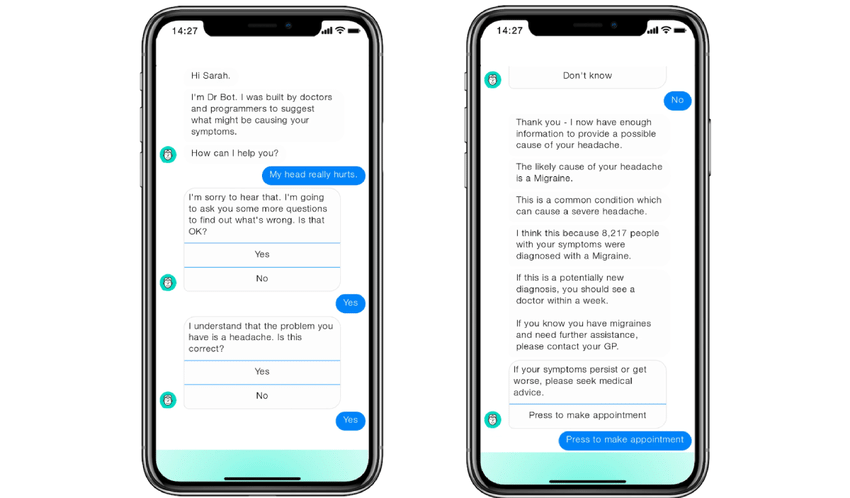
And just like that, your potential patient already feels heard and reassured, without ever waiting on hold.
"Sounds great, Sam, but I don't have time to set that up."
Actually, you don’t have time not to.
The good news is, it’s faster to get started than most people think, especially when you’re working with a platform tailored for aesthetic practices. Let’s break down what it actually takes:
The Setup (2–6 hours):
- Upload your most-asked questions (e.g., “Is Botox painful?”, “How long is recovery after microneedling?”) and their answers
- Add treatment descriptions and pre/post-care info
- Include policies, pricing, office hours, and booking instructions
You don’t necessarily need to start from scratch. Many platforms offer pre-built templates for aesthetic services that you can customize to match your voice and offerings.
Training & Testing (1–3 days):
- Review how the chatbot responds to sample questions
- Identify any gaps or misunderstandings
- Fine-tune how it escalates complex inquiries to your human team
You’ve probably spent more time tweaking your favorite Spotify playlist than you will training this thing.
Ongoing Maintenance (15–30 minutes/month):
- Add info about new treatments or procedures
- Update your holiday hours, location, etc.
- Refine answers based on real user interactions
That’s it. Spend a few hours setting it up, and watch it give you weeks of your life back. If that’s not ROI, what is?
Effortless Scheduling: Make Booking So Easy They Can’t Say No
Efficient scheduling is the backbone of a well-run aesthetic practice. Yet too often, it’s a point of friction. You’re drowning in missed calls and double bookings, and now that you’re fielding the fifth no-show of the week, you’re starting to wonder if your calendar is working for you or actively plotting against you.
AI can help eliminate these inefficiencies.
AI Scheduling Systems
With an AI-powered scheduling tool, patients can book directly through your website, Instagram DMs, or even by text, at any hour of the day. The system checks your real-time availability across all synced calendars, offers the best time slots based on your preset rules, and confirms the appointment instantly.
It’s like cloning your front desk, but without the PTO requests.
And it gets better. Your AI scheduling system also handles the follow-through. Automated reminders via text or email go out without fail, and if a patient needs to reschedule, they can simply reply. The system cancels the old slot, offers new ones, and keeps your schedule optimized without you lifting a finger:
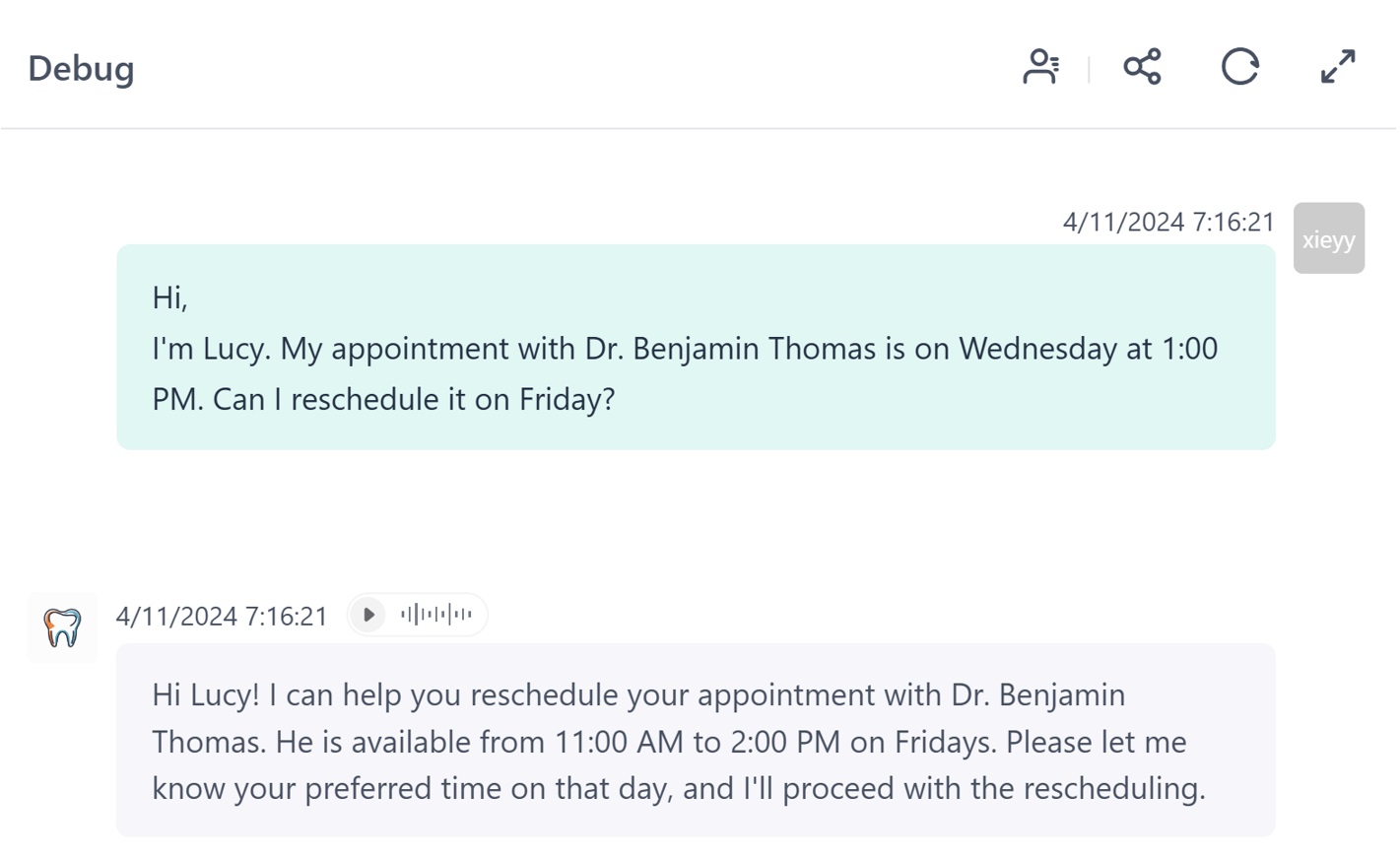
Here’s the truth: today’s patients expect Amazon-level convenience. If they can book a flight, a dinner reservation, and a dog groomer online in under five minutes, they expect the same from their aesthetic provider. If the experience is confusing or inconvenient, they hesitate—or worse, they don’t book at all. Every added step is a chance for distraction or doubt to creep in.
The smoother the booking, the faster they commit.
The faster they commit, the fuller your schedule.
And a full schedule—with zero chaos—is how modern practices grow.
During the Consult: Give Them 100% of You, While AI Handles the Paperwork
You went to med school. You did the years. You’ve got the hands, the eye, the reputation. People maybe even fly in for your expertise—and now I’m suggesting you need AI in the room with you during patient appointments?
Hear me out.
AI isn’t here to steal your spotlight. It won’t diagnose, treat, or tell a patient she’s chasing a trend she’ll regret in six months. That’s your job, and no algorithm is coming for it.
But it will make every consultation smoother and more persuasive. If you’re serious about giving your patients the full weight of your focus and expertise, and giving your business the best chance of success, you’ll take that seriously.
Real-time Note Taking
Let me paint a familiar picture. You’re mid-consult. The patient’s rapid-firing her concerns and questions like Tony Montana going out in a blaze of glory. You're doing mental somersaults trying to address it all.
Meanwhile, your brain’s doing a second job:
“Make sure to note her allergies… remember she mentioned spironolactone… jot down that she's interested in microneedling, but nervous about downtime...”
Maybe you have someone taking notes. But unless they’re extremely skilled and borderline clairvoyant, you’re reworking everything after hours anyway. Which means you’re doing the same work twice—once in your head, once in the EMR.
This is where AI steps in to level up your game.
Tools like DeepScribe are superpowered assistants that never miss a word and understand medical language as fluently as you do. They listen to your consult (securely, unobtrusively) and turn the conversation into clean, structured, near-final clinical notes: reason for visit, history, meds, symptoms, concerns, next steps. All of it.
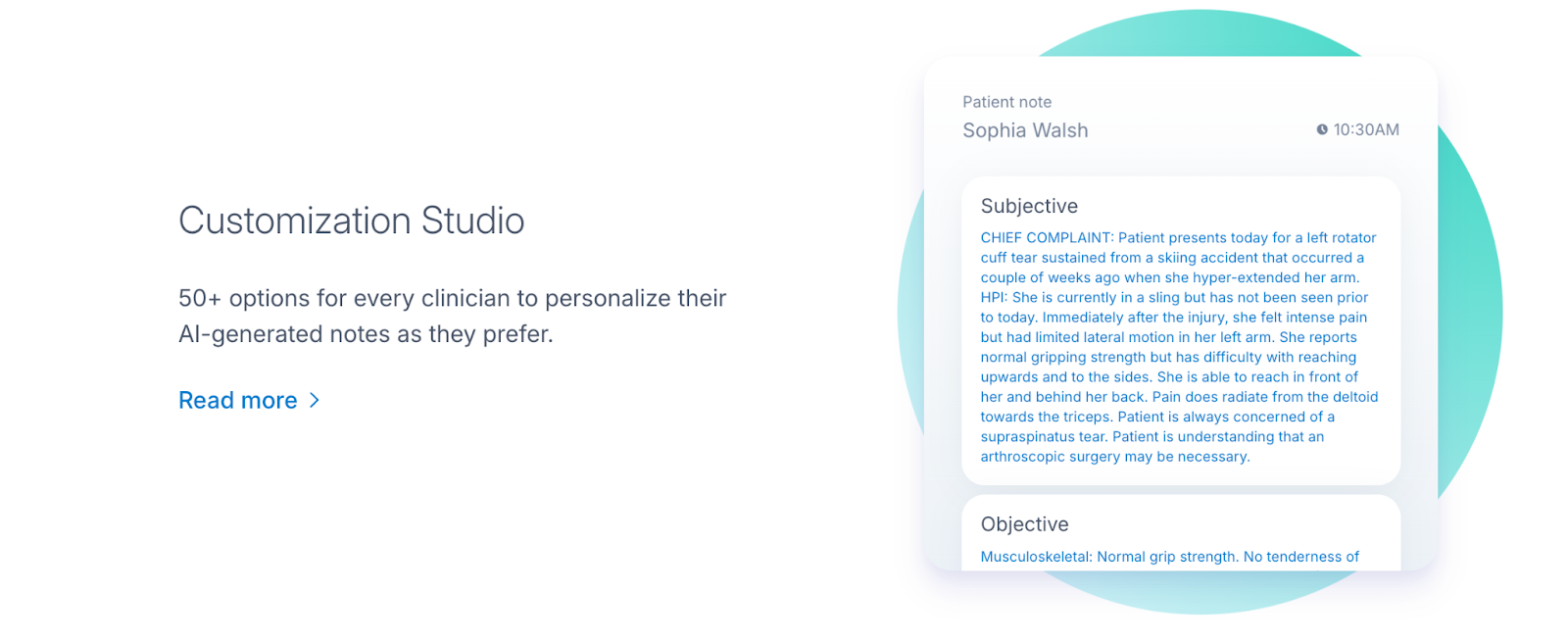
It’s ready before the patient even hits the exit. All you need to do is press “record”:
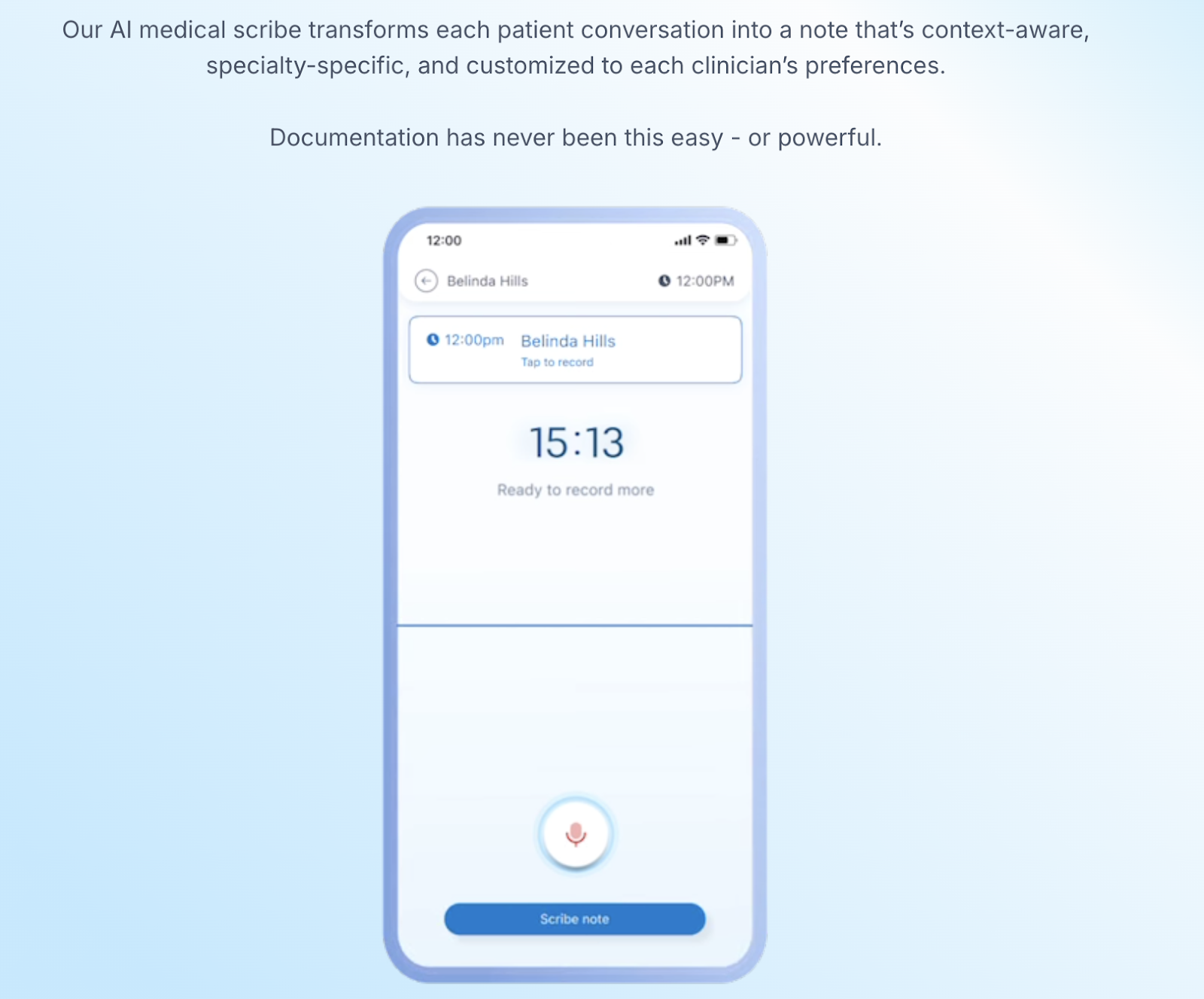
The setup is surprisingly simple. After a short onboarding, you just link the software to your EMR system (like PatientNow). Then you create your note templates or select from pre-built ones tailored to the aesthetic medicine industry.
You’ll spend the first few consults tweaking your AI scribe to get it just right. But once your inner Goldilocks is satisfied, you’ll wonder how you ever practiced without it. Your attention can stay where it belongs—on the patient, not the note-taking.
*Note - I use an AI powered bot to join all my Google and Zoom meetings. They listen, take notes, and submit action plans after the meeting. No getting distracted while I am in the meeting - I focus ON the meeting. Afterwards, I get a report with what is next and how to execute. I can also have everyone in the meeting get the same report. This is the same concept, but just for you medical providers.
Predictive Imaging
Your patient sits down and tells you they want to look “more refreshed” or “a little lifted, but not too much”.
Instead of relying on imagination to get on the same page (risky) or before-and-afters (useful but old school), you pull out a crystal ball and say: “Let me show you.”
No, not that crystal ball (unless you’re into the velvet drapes and incense vibe). This mystical fortuneteller is your phone… and an AI program like Crisalix:
Using a high-quality photo or a 3D scan, the app generates a personalized, real-time simulation of your patient’s potential results. You can adjust the settings to show different outcomes based on their actual treatment plan. You don’t have to guess what your patient wants, and neither do they. They see it right in front of them.
Predictive imaging bridges the gap between wishful thinking and real outcomes. It helps patients understand what’s possible—and just as importantly, what’s not. It builds trust, cuts through hesitation, and transforms the consult from abstract to undeniable.
That’s not a gimmick. That’s clarity.
And clarity turns “I’ll think about it” into “How soon can I book?”
Pre- and Post-Care: Deliver Better Instructions Without Burning Out
You crushed the consultation. The patient’s excited, and they’re hanging on to your every word.
Fast-forward 20 minutes: they’re back in their car, watching their 347th TikTok of the day, and the details start slipping.
Was it two days without makeup… or five?
Was it retinol I needed to avoid, or vitamin C?
Wait—can I do Pilates tomorrow, or is that off-limits too?
You know the importance of personalized pre- and post-treatment care instructions. Sometimes you manage to scribble out a few notes or highlight a sentence on the back of a treatment brochure before you’re pulled into another room. On a good day, you might send a follow-up email with a few extra reminders.
But let’s be real: when your calendar is stacked and the espresso’s wearing off, “personalized” care instructions start looking a lot like Ctrl+C, Ctrl+V.
You could use your trusty PDF template, but…
It doesn’t know they have sensitive skin.
It doesn’t know they’re allergic to nickel.
It doesn’t know they’re on Accutane.
You do.
Here’s another opportunity for your f-AI-ry godmother to swoop in and lend a helping hand.
Tailored Instructions
A chatbot like ChatGPT is all you need to create personalized, professional-grade instructions in seconds.
Let’s say your patient just booked a CO₂ laser session. She's a 42-year-old woman with mild rosacea and a nickel allergy, and she recently started low-dose Accutane. You open ChatGPT and type:
“Write pre- and post-care instructions for CO₂ laser for a 42-year-old woman with mild rosacea, a nickel allergy, and recent Accutane use. Include sun protection, skincare tips, and healing timeline. Tone: professional.”
A few seconds later, you’ve got a polished, medically accurate message you can send by text or email. Not a one-size-fits-all PDF, but a fully personalized experience that took you less than 60 seconds.
That’s not just good communication. That’s premium care at scale.
Automation
But wait—there’s more.
You can take it one step further and automate the whole thing. How?
- Build a simple patient intake form using a tool like Typeform or Google Forms.
- Ask patients to plug in their basics—skin type, medications, allergies, lifestyle notes, etc.
- Connect that form to ChatGPT using Zapier or Make (don’t worry, no coding required).
- Let ChatGPT turn that info into a customized, branded pre- or post-care message and instantly send it.
Your patients receive personalized care instructions the moment they book or leave your treatment room. Delivered automatically. In your voice. And you didn’t have to do a thing except be fully present in the room.
Give your patients better support and they’ll come back, again and again.
Between Visits: Stay Top of Mind Without Staying Chained to Your Inbox
Somewhere between reviewing before-and-afters and sterilizing instruments, you meant to send a follow-up email to the patient who came in for a laser consult. And you were planning to check in on yesterday’s Botox touch-up and circle back with the new lead who said she’d "think about it."
But now it's 5:30 PM, you’re tired, and let’s be honest, none of that is happening tonight.
You already know the solution I have for you, right? Say it with me: artificial intelligence.
With automated, AI-powered follow-up tools, post-consultation care doesn’t have to depend on your memory or your after-hours energy. The system automatically sends personalized messages based on exactly where the patient is in their journey.
A patient just had a treatment? They get a warm, clear post-procedure check-in via SMS:
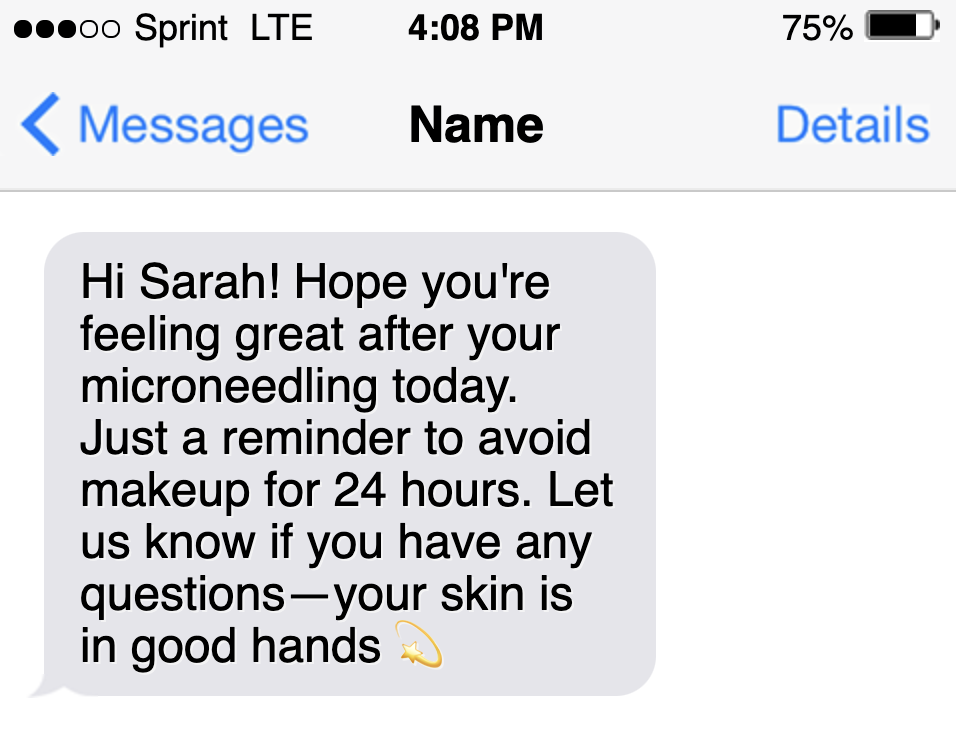
Someone had a consult but didn’t book? They get a gentle nudge:
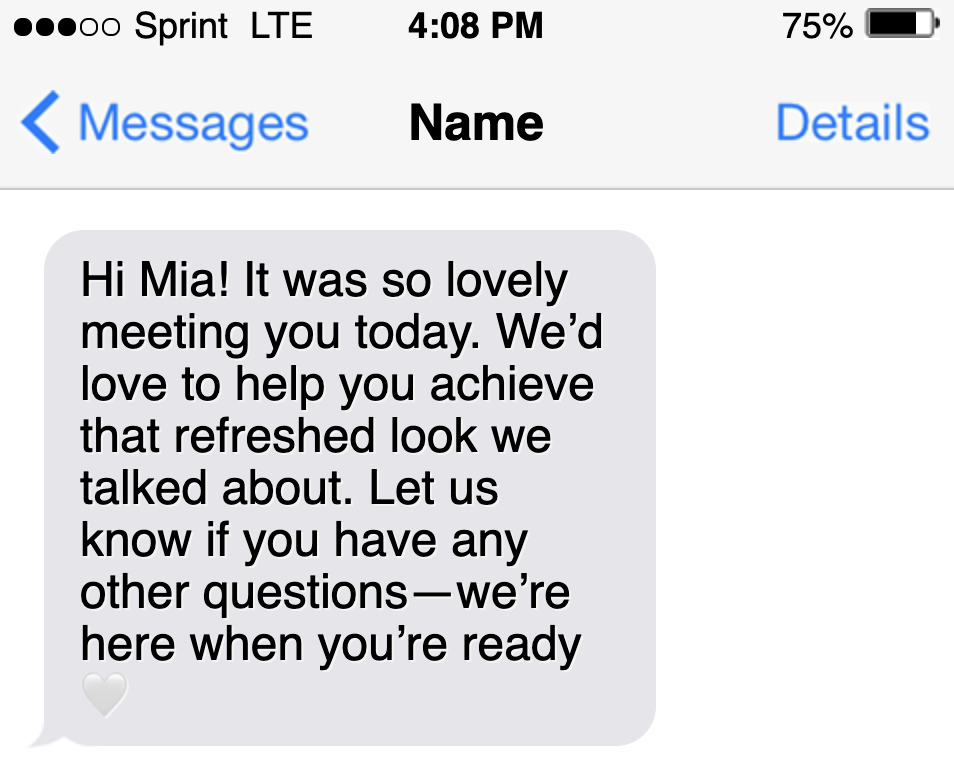
A lead interacted with your site but never scheduled? AI can send beautifully branded drip emails with before-and-afters, FAQs, or patient stories to nurture interest without pressure.
You can do it all with a single app like Klara:
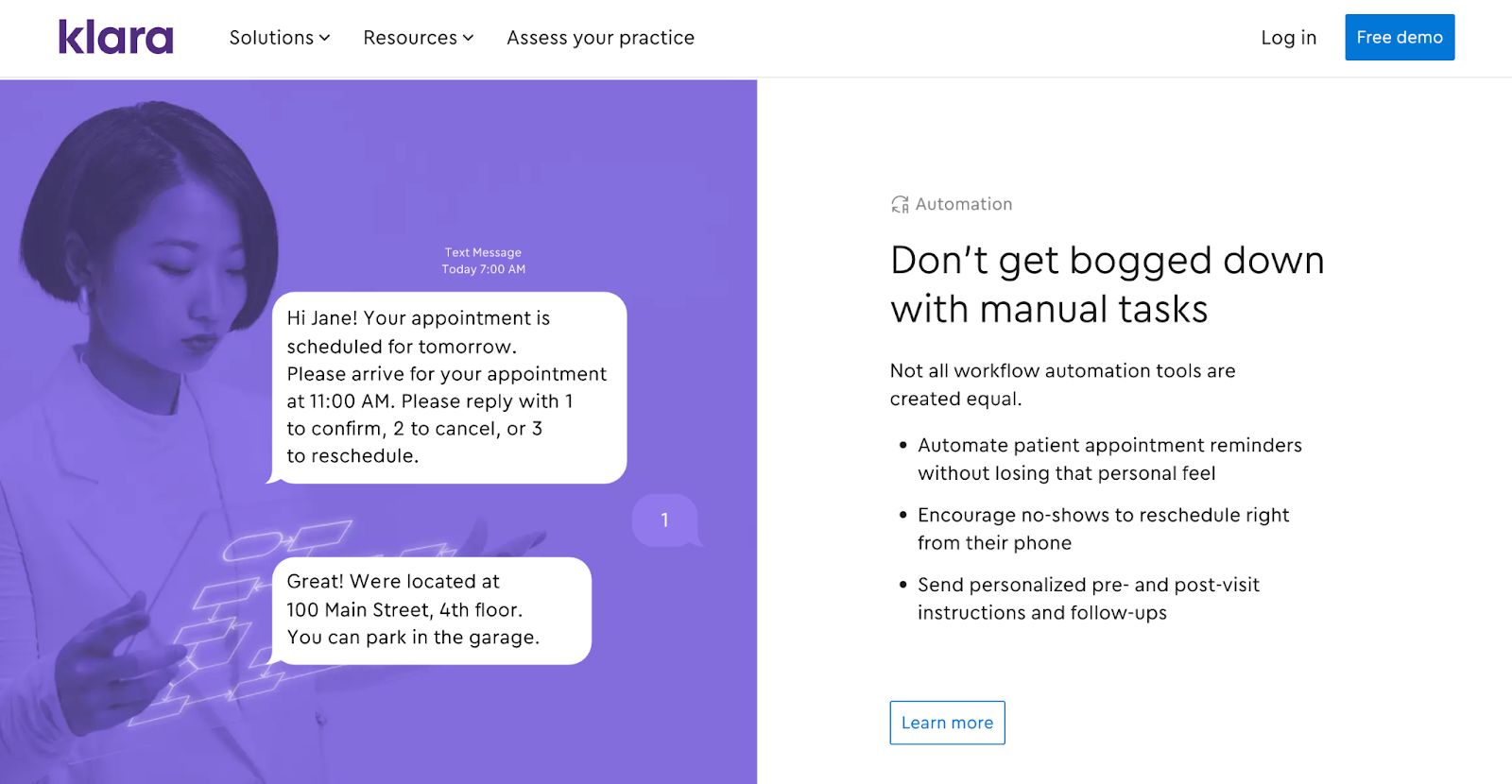
The best part? Every message feels like it’s from you, even if at the time it was sent, you were finally enjoying a peaceful family dinner.
Know Where To Draw The Line
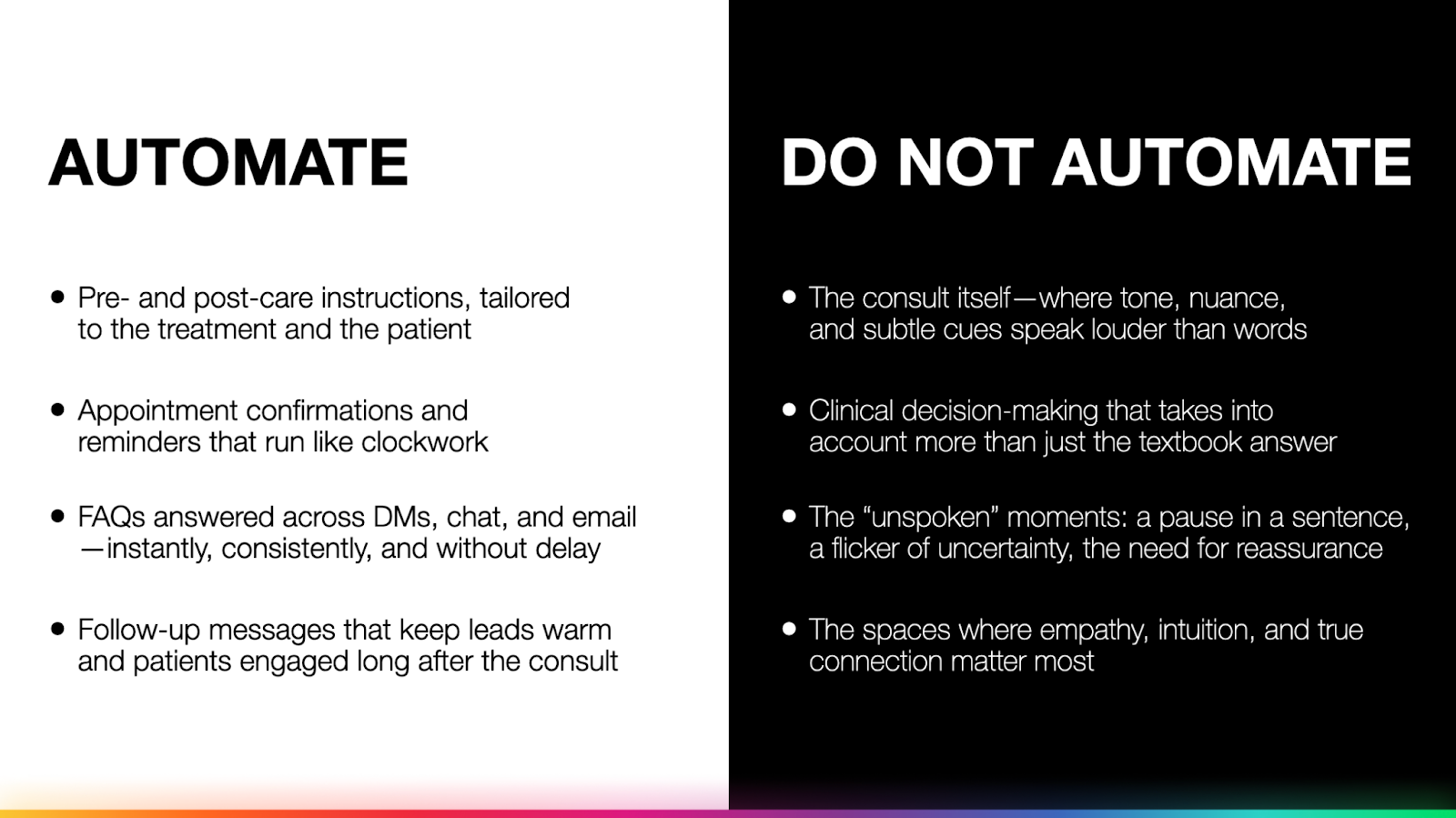
Here’s the part people often get wrong: they either automate nothing because they don’t trust the tech, or they try to automate everything and end up sounding like a robot.
Neither one wins.
The trick isn’t automating everything you possibly can (just say no to Skynet, kids). It’s knowing what to automate, and what to keep deeply personal.
Let AI handle the admin work that eats up your time (and honestly, might even be done better by a machine):
- Pre- and post-care instructions, tailored to the treatment and the patient
- Appointment confirmations and reminders that run like clockwork
- FAQs answered across DMs, chat, and email—instantly and consistently
- Follow-up messages that keep leads warm and patients engaged long after the consult
These are the logistical building blocks of your practice. They're essential, but not where your magic lives. So automate them. Let AI make them seamless, and refocus your energy on the parts of care that do need your eyes, your brain, and your heart:
- The consultation, where tone, presence, and personality speak louder than words
- Clinical decision-making that takes into account more than just the textbook answer
- Offering reassurance when you see a flicker of fear or uncertainty
- The spaces where empathy, intuition, and true connection matter most
Because no matter how advanced AI gets, it won’t feel real emotion.
Sure, it can analyze facial expressions or tone of voice, but it doesn’t understand what it’s like to be nervous about a procedure, to feel vulnerable in front of a doctor, to want something and fear it at the same time.
You’re not working with data points—you’re working with people. Real people with real fears, hopes, insecurities, and goals. That’s where your humanity has to shine. That’s the part no algorithm can touch.
You’re the Star, AI’s Your Sidekick
Bringing AI into your practice isn’t about turning patient care into a soulless sci-fi experience. It’s about giving you the space to deliver more human connection.
You’re the expert. The one patients come to when they’re nervous or hopeful. The one who hears what they mean, not just what they say. The one they book with, wait for, refer to, and return to because you deliver an experience no one else can.
Providing that level of care takes time. And time is exactly what you don’t have enough of. Between consults, post-ops, DMs, reminders, reschedules, paperwork, and those “quick” patient questions that somehow take 20 minutes to answer, something’s gotta give.
That’s why you should let AI take a part of patient care off your hands.
Not to strip away the soul from it, but to strip away the chaos from your day.
Appointment scheduling, note-taking, routine follow-up reminders—these are all predictable processes with clear protocols. AI excels at handling these efficiently and accurately, 24/7, without fatigue or frustration. When a machine handles what machines do best, you get to focus on what humans do best: connecting, caring, and bringing your irreplaceable clinical judgment to the patients who need it.
You’re still the star. AI’s just the backstage crew making sure the show runs flawlessly.
Too Long? Here's the Short Version
AI isn't here to replace medical providers—it's here to give you smarter ways to manage patient communication, scheduling, documentation, and follow-ups, plus streamline pre- and post-care processes, all without sacrificing quality. It improves efficiency, enhances the patient experience, and frees up your time so you can focus on what matters most: delivering high-level care, having meaningful conversations, and achieving real results. The goal isn't to turn your practice into a sci-fi movie—it's to give you back your time, energy, and focus so you can show up where it really counts: face-to-face with your patients.
AI isn't here to replace medical providers—it's here to give you smarter ways to manage patient communication, scheduling, documentation, and follow-ups, plus streamline pre- and post-care processes, all without sacrificing quality. It improves efficiency, enhances the patient experience, and frees up your time so you can focus on what matters most: delivering high-level care, having meaningful conversations, and achieving real results. The goal isn't to turn your practice into a sci-fi movie—it's to give you back your time, energy, and focus so you can show up where it really counts: face-to-face with your patients.










